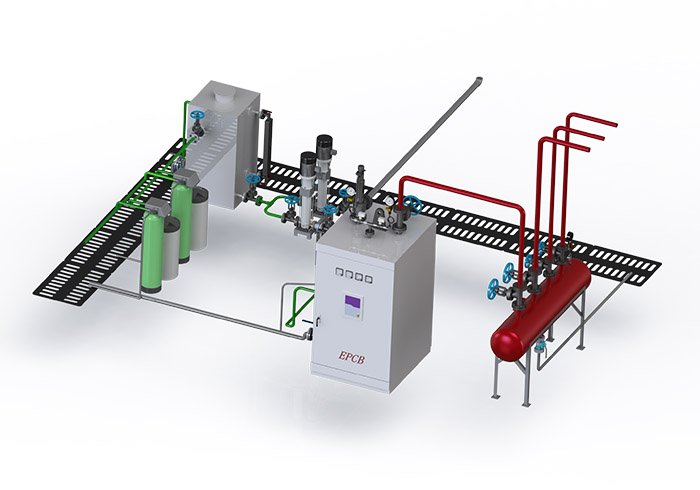Before the boiler is put into operation, the internal and external inspections must be carefully performed, especially the newly installed boilers or the boilers which pressure parts have undergone major repairs must be accepted by the relevant departments. After the boiler has passed annual inspection and refurbishment, preparations for starting can be carried out. How to start and operate the boiler correctly and to shut down the boiler for maintenance is very important.
EPCB specially summarized the general ways of industrial boiler operation, which has great guiding significance for you to use industrial boiler correctly.
1.Industrial boilers Start-stop operation
2.Industrial boilers Operation adjustment
3.Industrial boilers Shutdown and maintenance
Industrial boilers Start-stop operation
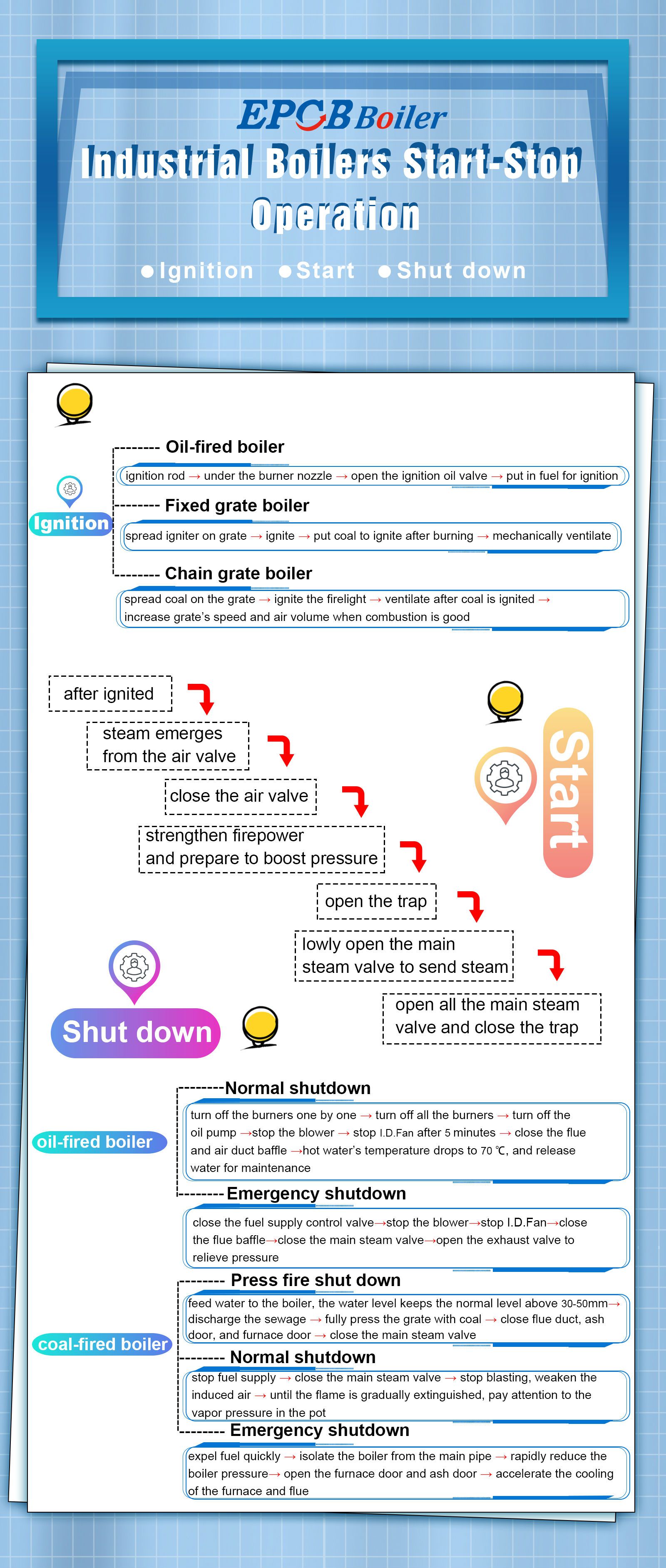
Ignition
How to properly ignite the boiler?
Before ignition, open the flue baffle and air duct baffle first, and the ash door of the coal-fired furnace must be opened, and natural ventilation for 10-15 minutes. When using mechanical ventilation, first turn on I.D.Fan and then F.D.Fan, or only turn on I.D.Fan for ventilation, but at this time, open the furnace door hole, and ventilation for 5 ~ 10 minutes to introduce fresh air and eliminate the residual in the furnace and flue Of combustible gas.You can start to ignition after prepared ignition tools and ignition items
1.Oil-fired boiler Ignition
Send the ignition rod to the front and bottom of the burner nozzle or turn on the electronic igniter, open the ignition oil valve, and put the fuel into ignition. After the furnace flame is stable, open the stop valves before and after the electromagnetic automatic control valve, start the electromagnetic valve to supply fuel, adjust the combustion to the normal state, and then gradually close the ignition valve.
During the ignition process, pay attention to monitoring the combustion situation in the furnace. If it does not catch fire immediately after fuel injection,close the fuel valve quickly and stop fuel supply, and investigated the cause and dealt with properly. At this time, the air distribution should be increased for 5-10 minutes, and increase the air distribution for 5-10 minutes. Re-ignite after remove the combustible gas in the furnace. When there are upper and lower fuel injection nozzles on the boiler, ignite the fuel injection nozzles below first, and then ignite the fuel injection nozzles above.
2. Fixed grate boiler Ignition
Spread the firelighter and firewood on the grate, ignite the firelighter to ignite the firewood, when the firewood is burned, put in lump coal to gradually ignite, and then put the coal to burn it. At this time, adjust the flue baffle to add large ventilation, when used mechanical ventilation, use fan to started for mechanical ventilation.
3. chain grate and reciprocating grate boiler Ignition
Spread a 20-30mm thick coal seam on the front of the grate, and spread firewood and firelighters (such as oil cotton yarn) on the coal. Ignite the firelighter, ignite wood and slowly rotate the grate, send the fire to about 1-1.5m away from the coal gate and stop the grate rotation. After ignited coa, start I.D.Fan and keep the furnace at a negative pressure of 0-10Pa (about 0~1mmH2O). When the current arch temperature gradually rises to ignite new coal, adjust the coal seam gate to make the coal seam thickness 70-100mm, and Start the grate to rotate slowly, and when the combustion is good, gradually increase the speed of grate.
When coal moved into the second air door, start the blower, and appropriately open the second air door. After the coal is burned to the third and fourth air doors, the third and fourth air doors are opened in sequence. When the coal is moved to the last air door, The coal should be basically burned out, so the last section of the air door generally does not need to open. When the entire grate is fully covered with coal and the combustion is in good condition, the thickness of the coal seam can be appropriately increased, the speed of the grate can be increased, and the air volume should be increased accordingly, and the negative pressure in the furnace should be maintained at 20-30Pa (about 2-3mmH2O), and try to use The combustion line is neat and evenly burning.
Start
How to start the steam boiler correctly?
After the boiler is ignited, the temperature raised slowly. When steam emerges from the air valve, close the air valve. At this time, enhance ventilation and firepower, and increase the pressure. In order to ensure that excessive temperature stress is not generated, the general low-pressure boiler below 1.25MPa, the time from cold ignition to rising to the working pressure is not less than 2h.
Pay attention to the following issues in boosting: control the combustion, make it gradually strengthen, and pay attention to maintaining stability: maintain the water level, when the water level is too high, take the lower water discharge method to reduce it; the outlet water temperature of the non-boiling economizer should be kept below the saturation temperature 20 -40℃, the available circulation pipeline without bypass flue baffle keeps the economizer outlet water temperature from being too high; in order to protect the superheater from burning out, open the trap of the superheater header during the heating process: After the valve on the steam pipe is opened, in order to prevent it from being stuck after thermal expansion, it should be fully opened and then turned half a circle: during the boosting process, the expansion instructions of each part should be recorded at any time according to the requirements of the operating regulations.
When a single boiler is running, when the steam pressure of the boiler rises to the working pressure, open the trap on the steam pipe and slowly open the main steam valve to heat the pipe and send steam. When the pressure in the pipe is equal to the steam pressure of the boiler, then all open the main steam valve and close the trap.
When several boilers send steam to a steam header pipe at the same time, the operation of sending steam to the header pipe from the newly-raised boiler is called steam incorporation. The method is when the steam pressure of the newly-raised boiler is lower than the steam header pipe by 0.05 ~0.1MPa When the time, open the trap on the steam pipe, slowly raise the main steam valve, turn half a circle after fully open, and close the trap when the steam is completed.
Pay attention to the following issues when combining steam: The boiler water should be kept at the lowest safe water level before combining steam, so as to prevent the steam from carrying water when the steam is combined, the laboratory personnel should be notified to analyze the steam, and the steam quality should be qualified when the steam is combined: turn on steam first when the steam is combined. The bypass valve of the parallel valve should be opened after the parallel valve. Opern the valve slowly. After the valve is opened, close the bypass valve and close the superheater trap; pay close attention to the changes in steam pressure, steam temperature, and water level during the parallel steam;
When the load is gradually increased to more than 50% of the rated evaporation after the steam is combined, open the flue damper of the economizer, close the bypass flue damper of the economizer, and close the economizer and recirculate the boiler without a bypass flue boiler. Make the economizer run normally, and put in the automatic water supply regulator.
Shut down
How to properly boiler shut down ?
Boiler shutdown is divided into normal shutdown and emergency shutdown. The normal shutdown is a planned shutdown. Interrupted the combustion slowly and reduce the load until the load of the boiler is reduced to zero. Emergency shutdown is an accident during the operation of the boiler, and the combustion is urgently interrupted, so that the load of the boiler is drastically reduced to zero.
(1) Oil-fired boiler Shutdown
Normal shutdown: turn off the oil burners one by one, and slowly reduce the load to avoid a rapid cooling of the furnace. Turn off all burners and turn off the oil pump, then stop the blower, stop I.D.Fan after 5 minutes, and finally close the flue and air duct baffle to prevent a large amount of cold air from entering the furnace. When the temperature of the hot water drops below 70C, the pot water can be released for maintenance and cleaning. Special personnel should be assigned to monitor the flue gas temperature of each section of the flue gas in the oil-fired boiler within 12 hours of shutdown. If an abnormal rise in the flue temperature is found, measures should be taken immediately to prevent secondary combustion at the tail of the boiler or in the flue.
Emergency shutdown: immediately close the fuel supply control valve in front of the furnace, first stop the blower, then stop I.D.Fan, close the flue baffle, close the main steam valve, disconnect from the heating pipeline, open the exhaust valve, and manually operate the safety valve push air to relieve pressure. If there is no shortage of water, you can also use the method of water supply and blowdown to reduce the furnace temperature and vapor pressure.
(2) Coal-fired boilers shutdown
In addition to normal shutdown and emergency shutdown, coal-fired boilers also have a pressure fire shutdown. Pressure fire shutdown is also a kind of planned shutdown, which is only applicable to layer-fired furnaces and circulating fluidized bed boilers. For pulverized coal furnaces, pressure fire shutdown is not possible.
Pressure fire shutdown: When the external load is reduced and the boiler needs to be temporarily stopped, the boiler can be compressed, and the fire can be picked up when it is necessary to resume operation. This can shorten the preparation work and boost time for fire and save energy. . Before pressing, the steam boiler should feed water and blow off the boiler, and keep the water level 30-50mm above the normal water level. When pressing the fire, use coal to completely compress the grate, and then close the flue duct baffle, ash door and furnace door. As the load decreases, the main steam valve should be closed. After pressing the fire, flush the water level gauge and have someone on duty to monitor the boiler.
Normal shutdown: Stop supplying fuel, the load of the steam boiler will gradually decrease, and the water level will be slightly higher than the normal water level. When the load stops, close the main steam valve, stop the air blowing and weaken the induced air, so that the burning flame is gradually extinguished and pay attention to the vapor pressure in the boiler. . The other operations are roughly the same as those of oil-fired boilers.
Emergency shutdown: Expel fuel quickly, isolate the accidental boiler from the main pipe, quickly reduce the boiler pressure, open the furnace door and ash door, and accelerate the cooling of the furnace and flue. Don’t extinguish the fire by pouring water into the furnace to extinguish the fire.
Industrial boilers operation adjustment
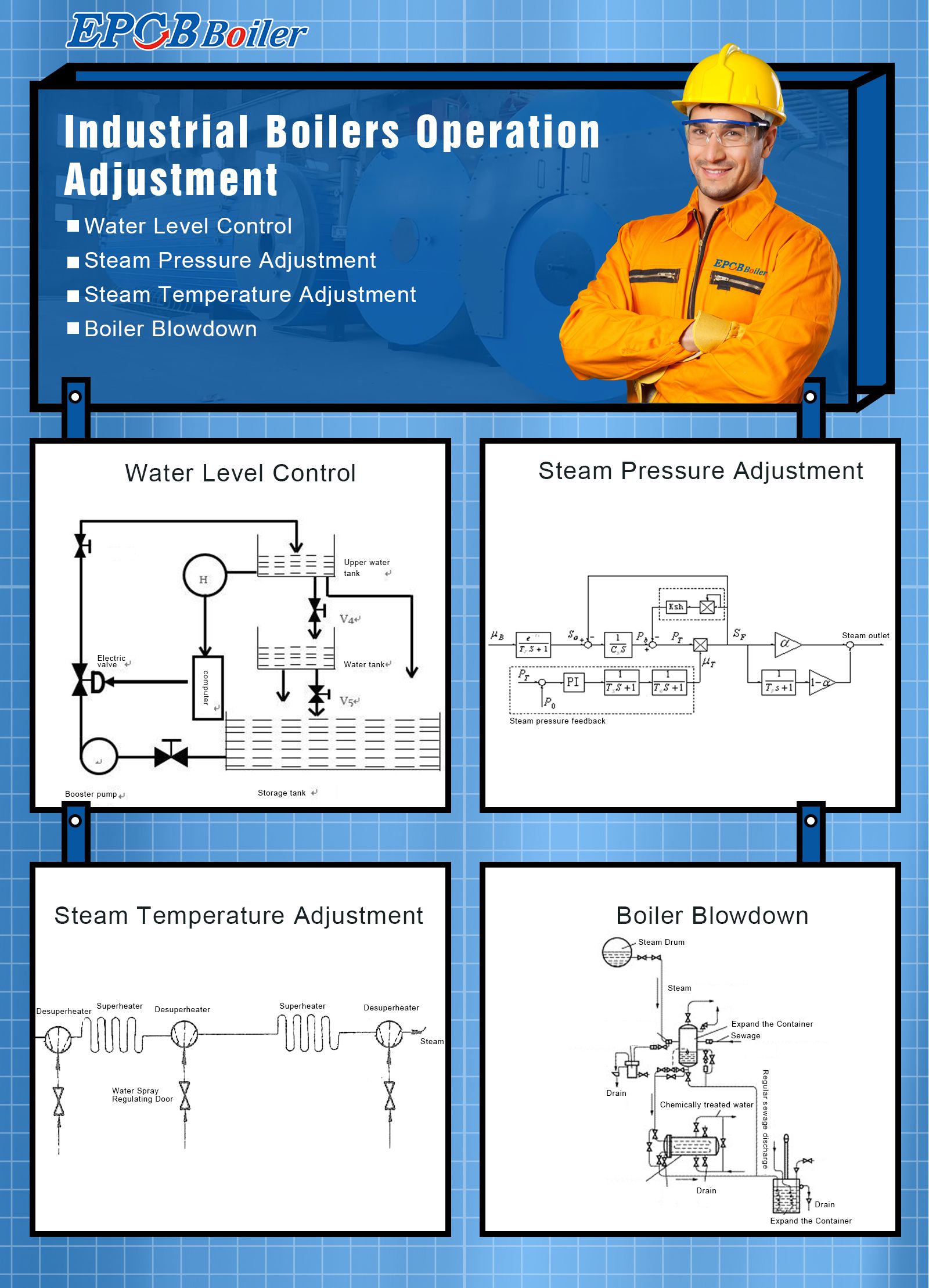
The operation adjustments of industrial boilers mainly include:
Boiler water level control and steam pressure, steam temperature adjustment and boiler blowdown.
Water level control
The change of water level affects the change of vapor pressure and micro-zone volume: conversely, the change of vapor pressure and evaporation volume will also cause the change of water level. The change in water level actually reflects the balance between water supply and evaporation. When the feed water volume is greater than the evaporation volume, the boiler water level rises; when the evaporation volume is greater than the feed water volume, the water level drops; when the boiler feed water volume is equal to the evaporation volume, the water level remains unchanged.
Therefore, in order to maintain the normal water level of boiler households, the water supply must be adjusted in time to adapt to the changes in evaporation.
In order to ensure that the water level does not change too much, keep water level slightly lower when the amount of evaporation is high, and keep water level higher when the amount of evaporation is low.
Grasp the relationship between water supply and steam pressure, and make correct observations and judgments on the trend of water level changes at any time: When the external load increases sharply, the water level first rises and then drops due to the decrease of the steam pressure: When the external load drops sharply, the steam pressure Rising will cause the water level to fall first and then rise. When the combustion intensity in the furnace is strengthened, the water level first rises and then drops; when the combustion in the furnace weakens, the water level first drops and then rises.
Steam pressure adjustment
During normal operation, keep the vapor pressure stable and should not exceed the maximum allowable working pressure.
The change of steam pressure during boiler operation actually reflects the relationship between evaporation and external load. In the case of constant evaporation, when the external load increases, the vapor pressure will decrease. Conversely, when the external load decreases, the vapor pressure will increase: Under the condition of constant external load, when the combustion weakens and the evaporation decreases, the vapor pressure will decrease: vice versa. When the combustion-enhanced evaporation increases, the vapor pressure will rise. In addition, under stable combustion conditions, even if there is no change in the external load, the change in vapor pressure will be caused by a larger adjustment of the water supply.
Controlling the vapor pressure in a stable range is actually achieved by adjusting the combustion and changing the amount of evaporation.
When the boiler steam pressure decreases, the evaporation capacity should be increased, and strengthen combustion, that is, increase the amount of induced air, air supply, and increase the amount of fuel; on the contrary, when the evaporation capacity needs to be reduced, the amount of fuel should be reduced, and the air supply and induced air volume should be reduced. . For the oil return adjustment system, the general return pressure is controlled at about 1.4-1.7kPa. When the return oil exceeds this value, it should be ensured by reducing the number of burners. This is conducive to the atomization of the mechanical nozzle and ensures stable combustion.
When multiple furnaces are operating in parallel, one of them can be set as an adjusting furnace, and the other boilers can be set as a fixed boiler. Smaller load and steam pressure changes are adjusted by the adjusting furnace.
Steam temperature adjustment
For boilers without superheaters, the change of steam temperature is mainly reflected in the change of boiler steam pressure. For boilers with superheaters, the change in steam temperature is determined by the heat release of the flue gas on the flue gas side of the superheater and the heat absorption of the steam on the steam side, but mainly depends on the flue gas heat release. When the flue gas temperature, flue gas volume, or flue gas flow rate passing through the heater changes, the temperature of the superheated steam will rise or fall.
For boilers equipped with a desuperheater, the outlet steam temperature of the superheater is achieved by adjusting the combustion and air supply on the one hand: When the temperature of the superheated steam is low, increase the flame center temperature or strengthen the ventilation to speed up the flue gas flow rate; When the steam temperature is high, lower the flame center temperature, weaken ventilation, and reduce the flue gas flow rate . On the other hand, the steam temperature at the outlet of the superheater is controlled by adjusting the amount of desuperheating water: when the steam temperature tends to rise, increase the desuperheating water flow; when the steam temperature tends to drop, close the desuperheating water regulating door appropriately , To keep the steam temperature stable.
Desuperheaters are divided into surface desuperheaters and water spray desuperheaters. Surface type desuperheater desuperheating water and steam do not directly contact, and the water quality requirements are low. Generally, part of boiler feed water is used as desuperheating water, and after the surface type desuperheater, it is fed with other boilers and sent to the boiler; spray water desuperheater The desuperheating water is in direct contact with steam, which requires high water quality. Generally, condensed water is used as desuperheating water. The desuperheating water vaporizes after passing through a water spray desuperheater and absorbs heat to reduce the temperature of superheated steam. Finally, it is sent to hot users together with superheated steam.
Boiler blowdown
During the operation of the boiler, the salt content in the stool water is constantly increasing due to the continuous evaporation and concentration of the boiler water. The main function of sewage discharge is to remove the sludge and dirt in the boiler water, reduce the salt content of the boiler water, and keep the water side of the heating surface clean and good steam quality. Sewage discharge devices are divided into two types: regular river discharge and continuous discharge devices.
Regular blowdown is generally installed at the bottom of the heating surface such as the boiler and the header, and is generally composed of two series-connected sewage valves and sewage pipes. The length of the interval between regular blowdown and the amount of sewage mainly depends on the quality of the boiler water. Commonly used blowdown valves are plug blowdown valves.
Continuous blowdown is also called surface blowdown. Its function is to discharge the pot water with high salt content between 100-150mm below the evaporation surface of the pot to reduce the salt content of the pot water and improve the quality of the steam. Generally installed at the upper boiler evaporation surface of a water tube boiler with a large evaporation capacity, it is composed of a hidden stop valve, a throttle valve and a sewage pipe. A sewage pipe with a diameter of about 75 ~ 100mm is arranged along the longitudinal axis in the upper drum. There are multiple open short pipes welded at appropriate distances. In this way, the high-concentration salt in the pot water is sucked by the short pipe and flows out after being merged by the sewage pipe. Even if the water level fluctuates, the sewage will not be interrupted. The amount of sewage is controlled by the throttle valve. In order to reduce the heat loss of blowdown, the blowdown should be led to the expansion tank and heat exchanger for recycling as much as possible.
The size of the boiler blowdown is directly related to the quality of the feedwater. The greater the alkalinity and salt content of the feedwater, the more blowdown required by the boiler.
Industrial Boilers Maintenance
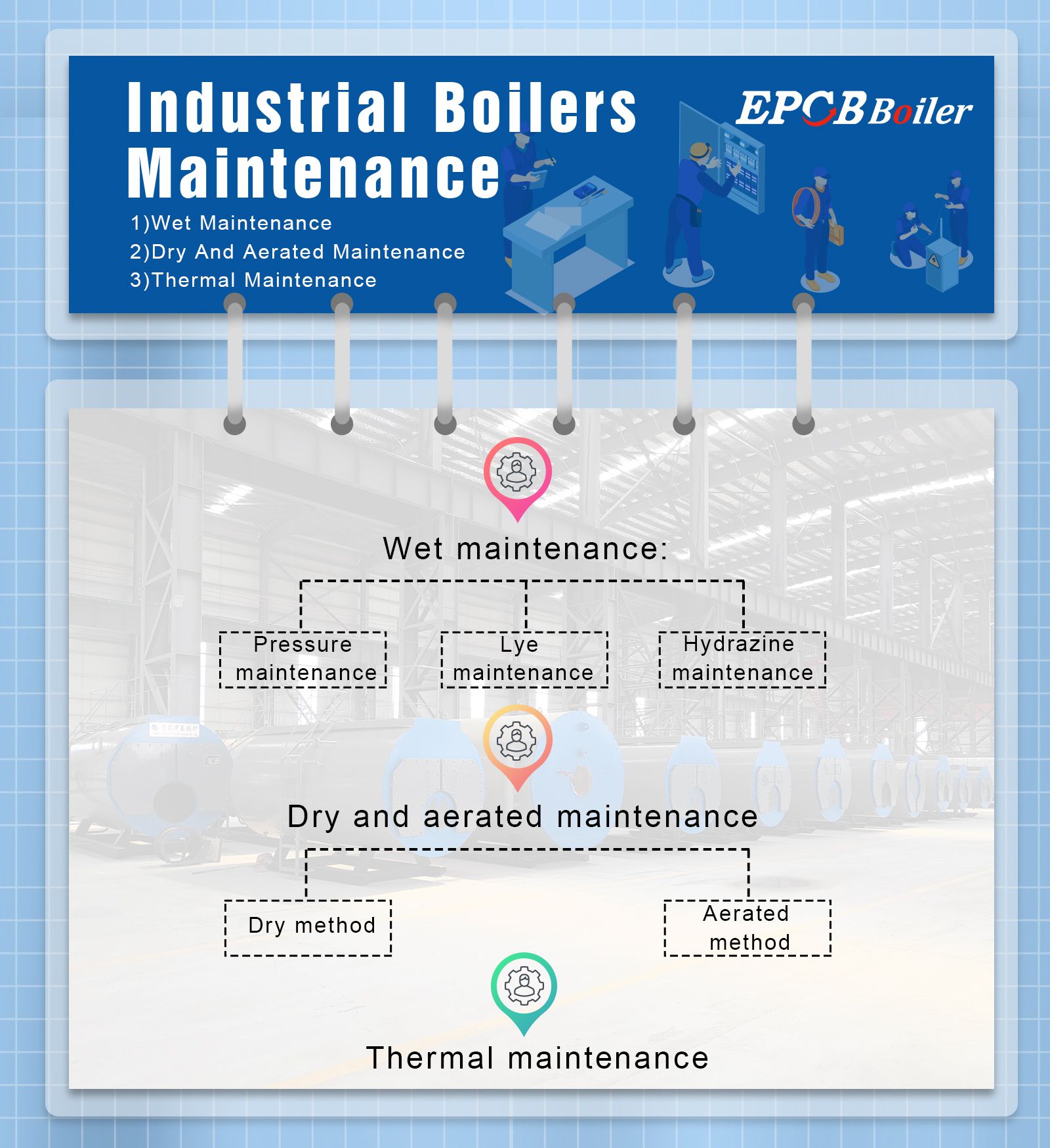
The boiler should be well maintained after it is out of service to prevent rust. There are many maintenance methods, which should be simple, effective, and economical, and appropriate maintenance methods should be selected according to specific conditions such as the shutdown requirements.
Wet Maintenance
This method is mostly used for boilers that have been shut down for a short period of time. There are pressure maintenance methods, hydrazine maintenance methods, and lye maintenance methods.
Pressure maintenance is to maintain a gauge pressure of 0.1-0.3MPa in the boiler to make the boiler water temperature higher than 100°C. In this way, the air cannot enter and achieve the purpose of anti-corrosion. This method is the simplest and is widely used.
It takes a long time to stop use (within 30 days) and can be maintained with lye. A certain concentration of alkaline solution has antiseptic effect. Alkaline solution can be prepared by adding 2-5kg of NaOH or 5 -10kg of Na3PO4▪12H2O or 10-20kg of Na2CO3 per ton of soft water. The prepared alkali solution is pressed into the boiler with a chemical pump, and the boiler is ignited for 2-3 hours to make the boiler The outer wall is dried and the lye is evenly distributed in the pot. After the boiler is turned off, use pump to maintain a gauge pressure of 0.15-0. 4MPa in the pot to prevent the air from escaping in tight places.
When using lye for maintenance, remove the remaining lye when the boiler is restarted. Hydrazine maintenance is better when the boiler is used for long-term standby. This method utilizes the strong reducibility of hydrazine (N2H4), which can combine with oxygen or oxides in water to generate non-corrosive compounds, thereby achieving the purpose of corrosion protection. Hydrazine should be prepared with special equipment and injected into the boiler. After injection, the boiler maintains a gauge pressure of 0.1-0. 3MPa, and the hydrazine concentration should be 300mg/L. During the maintenance period, samples of pot water should be taken for testing. When the ammonia concentration drops to 100mg/L, add N2H4. If the pH value is lower than 10, add ammonia.Hydrazine itself is a toxic substance, so you should be especially careful when operating it, and the boiler should be rinsed clean when restarting.
Dry and Aerated Maintenance
It is used for long-term boiler shutdown for maintenance. The dry method is to drain the water after the boiler is shut down to dry, and then put a water-absorbing agent or full of anti-corrosion gas in the boiler. The water absorbing agent generally uses CaCl2, silica gel, quicklime, etc., and the dosage is 2 ~ 3kg/m3. After placing the water absorbing agent in the pot, close all door holes, and then check and replace the water absorbing agent regularly (such as one month). The aeration method is to charge the inert gas N2 or ammonia gas with anti-corrosion effect into the boiler. The N2 should be 0.3MPa gauge pressure and the purity should not be less than 98.5%.Ammonia gas should be charged from the upper part of the boiler, and after being full, the gauge pressure should be maintained at 0.013MPa, and the amount should be about 0.6kg/m3.
Thermal Maintenance
Thermal maintenance is used to stop the furnace within 10 days. The method is to place a water tank above the drum and connect it to the drum with a pipe. After the boiler is shut down, it is filled with deoxygenated water. The water level in the water tank is maintained at 2/3 height, and external steam is used for heating, so that the water in the water tank is always kept in a boiling state. The loss of boiler water, the water in the water tank is automatically replenished, this method is compared It is simple, and it is more convenient to put into operation after stopping the furnace, as long as the water tank and the drum are cut off. The disadvantage of thermal maintenance is need an external source of steam to supply steam.
EPCB,your private boiler expert!
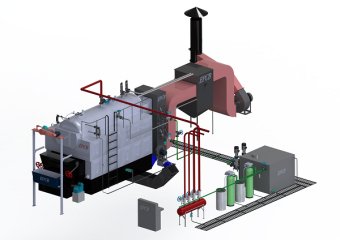 Steam Boiler
Steam Boiler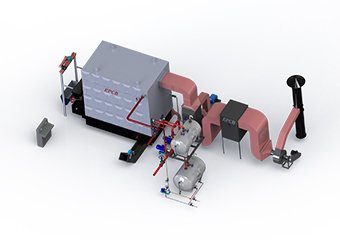 Thermal Oil Boiler
Thermal Oil Boiler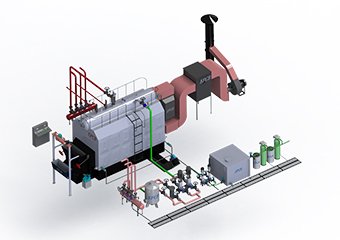 Hot Water Boiler
Hot Water Boiler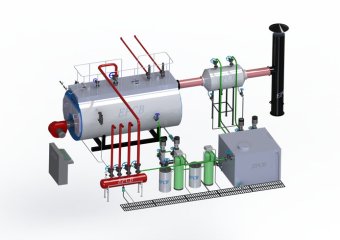 Steam Boiler
Steam Boiler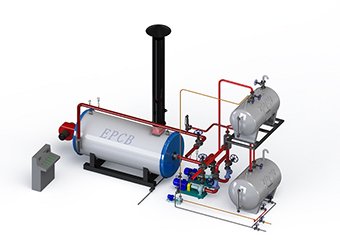 Thermal Oil Boiler
Thermal Oil Boiler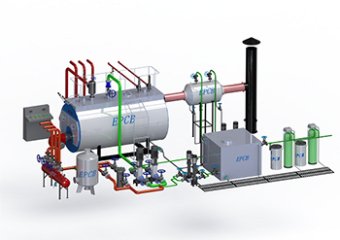 Hot Water Boiler
Hot Water Boiler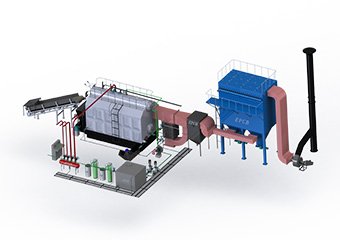 Steam Boiler
Steam Boiler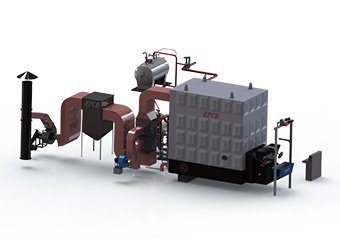 Thermal Oil Boiler
Thermal Oil Boiler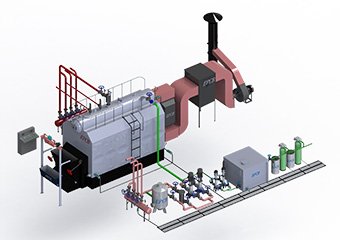 Hot Water Boiler
Hot Water Boiler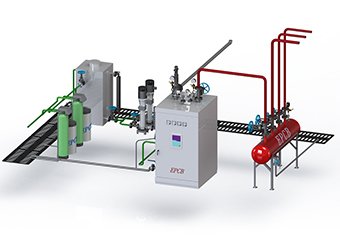 Steam Boiler
Steam Boiler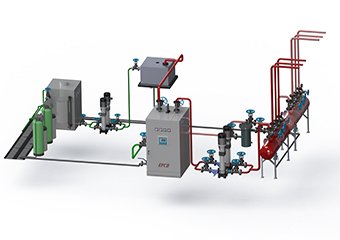 Hot Water Boiler
Hot Water Boiler

















